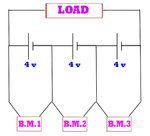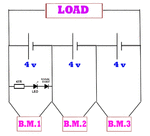rajaram04
Advanced Member level 3
Hello everyone 
Here as shown below may be i am doing a totally wrong thing but . . .
i am trying to design a simple but a typical design of battery monitor (B.M.) for 3 batteries of each 4 volts 1 mAH , which i connected further in series to get 12 volts out

please tell me about errors & too explain about how to move it out
Reason i am designing it is just because when i connect any kind of full load for say 3 or 4 hours , i get a decrease in voiltage for each battery but with very diffrent value like
for battery near +ve side it shows 3 volts
for middle battery it shows 4 volts
& for last one near -ve side it shows 4.3 to 4.5
Given voltage regulation for batteries in standby mode are 4.7v-4.9v which i checked that all of them holds same value in rest
so i need a separate monitors for all of them ,
please help me in finding a right way
Here as shown below may be i am doing a totally wrong thing but . . .
i am trying to design a simple but a typical design of battery monitor (B.M.) for 3 batteries of each 4 volts 1 mAH , which i connected further in series to get 12 volts out

please tell me about errors & too explain about how to move it out
Reason i am designing it is just because when i connect any kind of full load for say 3 or 4 hours , i get a decrease in voiltage for each battery but with very diffrent value like
for battery near +ve side it shows 3 volts
for middle battery it shows 4 volts
& for last one near -ve side it shows 4.3 to 4.5
Given voltage regulation for batteries in standby mode are 4.7v-4.9v which i checked that all of them holds same value in rest
so i need a separate monitors for all of them ,
please help me in finding a right way
